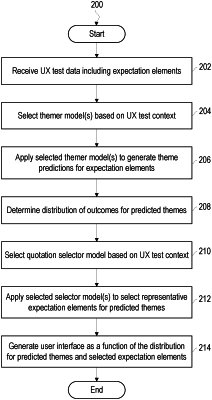| CPC G06F 11/3692 (2013.01) | 20 Claims |

|
1. A method comprising:
identifying a set of expectation elements associated with one or more user experience tests, wherein an individual expectation element in the set of expectation elements specifies, using unstructured data that does not conform to a schema, an expectation for a user experience and a respective outcome for the user experience;
generating, by a first machine learning model for each expectation element in the set of expectation elements, a prediction that maps the respective expectation element to a predicted theme from a theme schema, wherein the set of expectation elements are mapped to a plurality of predicted themes from the theme schema;
generating, by a second machine learning model that is different than the first machine learning model, a selection score for each expectation element in the set of expectation elements;
determining a distribution of expectation elements across the plurality of predicted themes; and
presenting, within a user interface, at least one theme from the theme schema and at least one respective outcome for at least one expectation element mapped to the at least one theme by the first machine learning model, wherein the respective outcome is selected to present in the user interface based at least in part on the selection score for the expectation element generated by the second machine learning model;
wherein the user interface includes at least one interactive user interface element that is generated based at least in part on the distribution of expectation elements across the plurality of predicted themes and a distribution of outcomes associated with at least a subset of the plurality of predicted themes, wherein interactions between a user and the interactive user interface element are determined based at least in part on the distribution of expectation elements across the plurality of predicted themes and the distribution of outcomes associated with at least a subset of the plurality of predicted themes.
|